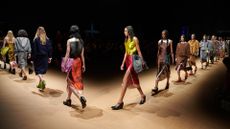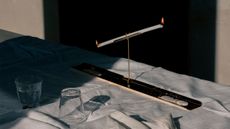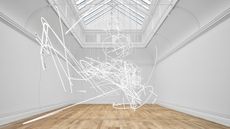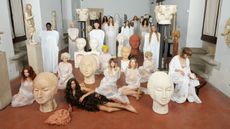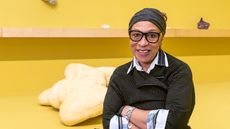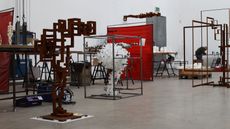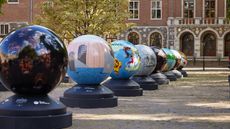Welsh artist Cerith Wyn Evans on winning the Hepworth Prize for Sculpture
- (opens in new tab)
- (opens in new tab)
- (opens in new tab)
- Sign up to our newsletter Newsletter

The winner of the £30,000 biennial Hepworth Prize for Sculpture 2018 has been named as Cerith Wyn Evans: Welsh conceptual artist, filmmaker and contemporary sculpture’s golden child.
There’s no doubt that Wyn Evans has been basking in his element in recent years. Many will recall his electric intervention in the White Cube’s Bermondsey gallery earlier this year, or his highly Instagramable neon occupation of Tate Britain in 2017. Rewind further to the 1980s when he produced two music videos for The Smiths and the short film Degrees of Blindness (starring Tilda Swinton) and it becomes apparent that this is an artist with fingers in most creative pies.
Now he’s rooted in sculpture, a discipline he admits he ‘used to hate’. ‘I’ve got to try and bring my best into a situation which inspires whoever has the patience to look at it. If those people are youngsters then glory be to God!’ he exclaims.

Portrait of Cerith Wyn Evans. Courtesy of the artist
His levitating, site-specific work at the Hepworth Wakefield, Composition for 37 Flutes (in two parts), first coaxes the viewer through sound. Two intersecting glass arcs hold pipes emitting musical notation wavering between harmony and dissonance. A pair of mechanical lungs inhale, exhale and coordinate the instruments through a precisely programmed algorithm. An unnerving, biological timbre evokes the rasp and rhythm of the human respiratory system.
What sets this work apart is its bond with the building. It breathes – not just through Wyn Evans’ intricately crafted organism – but also through the pumps and pipes of architect David Chipperfield’s cacophonous concrete museum. This is a piece that occupies the eyes, ears and personal space of consenting viewers alongside the arteries of the building itself.
‘It [the prize] means nothing, but I’m a buddhist you see,’ he said shortly after collecting his award. ‘Raising awareness is a different issue. I want to show people that I have a certain compassion for the world, but the world is empty and meaningless and the universe doesn’t give a shit about us.’

Composition for 37 flutes (in two parts), 2018, by Cerith Wyn Evans, 37 crystal glass flutes, ‘breathing’ unit and valve system, plastic tubes, installation view at The Hepworth Wakefield.
The other nominated artists – Michael Dean, Mona Hatoum, Philip Lai and Magali Reus – have each generated distinctive and compelling work, carving out their own corner of sculptural territory.
Dean’s Of Or for LOL is meticulously organised chaos. The perimeter of the space is lined with drooping incident tape that reads simply: ‘sorry’. Within the main composition, the artist channels ‘moments of intensity’ through building materials, litter and a mound of pennies totalling a three-day emergency food bank allowance for a family of four. In any case, there doesn’t appear to be a great deal to ‘laugh out loud’ about.
Hatoum offers up the breadth of her deft material ability, marrying mundane objectivity, juxtaposition and upsurges of violence. Her globe Hot Spot, perched on a head height pedestal, outlines the continents in pulsating red neon, accompanied by a piercing electrical hum. In a modestly sized steel cabinet, the artist’s Murano glassblown sculptures – delicate and regal – first appear to be perfume bottles but are in fact casts of hand grenades; a sculpture both exquisite and ferocious.
Meanwhile, Lai stages domesticity and mass production as poetry, or as he puts, it, of an ‘absurd expenditure of labour’. His new untitled work comprising wall-mounted washing up bowls soiled with concrete appear as both tools to create and the creation itself. His 2016 Guest loves host in a way like no other, further conveys themes of ‘home’ in a seemingly functional and precise brushed aluminium kitchen island.
Dutch artist Reus presents new works from her complex Sentinel series. Sculptures reminiscent of the whimsical contraptions of Heath Robinson are twisted into contemporary contexts through objects resembling fire hoses, hospital equipment and metal appendages. These articles on the cusp of functionality are warped until rendered obsolete. Another body of new work, Dearest explores romantic narratives through ‘ladders’ personified through props like hats and bottles.
The 2018 judging panel comprised Sarah Brown, Leeds Art Gallery senior curator; Martin Clark, Camden Arts Centre director; Margot Heller OBE, South London Gallery director; and Helen Legg, Tate Liverpool director. The prize was chaired by The Hepworth Wakefield director Simon Wallis OBE. The winner was picked from a shortlist of UK-based artists of different ages, at different stages of their careers. Wyn Evans follows inaugural recipient Helen Marten in 2016.
Visitors to the exhibition will have the opportunity to vote for their own best in show (opens in new tab), with the winner announced online in January. All five artists will exhibit at The Hepworth Wakefield until 20 January 2019.
INFORMATION
The Hepworth Prize for Sculpture exhibition is on view until 20 January 2019. For more information, visit the Hepworth Wakefield website (opens in new tab)
ADDRESS
The Hepworth Wakefield
Gallery Walk
Wakefield WF1 5AW
Harriet Lloyd-Smith is the Arts Editor of Wallpaper*, responsible for the art pages across digital and print, including profiles, exhibition reviews, and contemporary art collaborations. She started at Wallpaper* in 2017 and has written for leading contemporary art publications, auction houses and arts charities, and lectured on review writing and art journalism. When she’s not writing about art, she’s making her own.
-
 2022 fashion highlights, as picked by the Wallpaper* team
2022 fashion highlights, as picked by the Wallpaper* teamThe Wallpaper* fashion and beauty team reflect on their personal 2022 fashion highlights – from Gaetano Pesce at Bottega Veneta and Wales Bonner in Florence to intrigue and seduction at Prada
By Jack Moss • Published
-
 Marre Moerel’s swinging flame candle uses artful balance
Marre Moerel’s swinging flame candle uses artful balanceVita Balanza by Marre Moerel and Santa & Cole has turned candles into a balancing act
By Martha Elliott • Published
-
 At home with Neri & Hu
At home with Neri & HuArchitectural super-pair Neri & Hu talk to us about what inspires them, what they are reading, and how they switch off
By Ellie Stathaki • Published
-
 Cerith Wyn Evans: ‘I love nothing more than neon in direct sunlight. It’s heartbreakingly beautiful’
Cerith Wyn Evans: ‘I love nothing more than neon in direct sunlight. It’s heartbreakingly beautiful’Cerith Wyn Evans reflects on his largest show in the UK to date, at Mostyn, Wales – a multisensory, neon-charged fantasia of mind, body and language
By Harriet Lloyd-Smith • Published
-
 Vanessa Beecroft’s ethereal performance and sculpture exhibition explore Sicily’s cultural history
Vanessa Beecroft’s ethereal performance and sculpture exhibition explore Sicily’s cultural historyAt the historic Palazzo Abatellis, Sicily, Vanessa Beecroft has unveiled ‘VB94’, a new tableau vivant comprising a one-time performance and a new series of sculptures, the latter on view until 8 January
By Hili Perlson • Published
-
 London art exhibitions: a guide for this week
London art exhibitions: a guide for this weekYour guide to the best London art exhibitions, and those around the UK, as chosen by the Wallpaper* arts desk
By Harriet Lloyd Smith • Last updated
-
 Veronica Ryan wins the 2022 Turner Prize
Veronica Ryan wins the 2022 Turner PrizeVeronica Ryan, the artist who honoured the Windrush generation, has been named winner of the 2022 Turner Prize in a ceremony held in Liverpool
By TF Chan • Published
-
 Yayoi Kusama interview: ‘Painting helps me to keep away thoughts of death’
Yayoi Kusama interview: ‘Painting helps me to keep away thoughts of death’We interview legendary Japanese artist Yayoi Kusama, who discusses her major retrospective at M+, Hong Kong, the ‘power of art’, and her desire, at 93 years old, ‘to create ever more original works’
By Megan C Hills • Last updated
-
 Antony Gormley interview: ‘We’re at more than a tipping point. We’re in a moment of utter crisis’
Antony Gormley interview: ‘We’re at more than a tipping point. We’re in a moment of utter crisis’We visit the London studio of British sculptor Antony Gormley ahead of his major new show ‘Body Field’ at Xavier Hufkens Brussels
By Harriet Lloyd-Smith • Last updated
-
 The World Reimagined revisits the history of the transatlantic slave trade through art
The World Reimagined revisits the history of the transatlantic slave trade through artAhead of a Bonhams auction on 21 November, The World Reimagined will conclude with an epic finale in Trafalgar Square this weekend (19 and 20 November). The initiative uses art to illuminate the history of the transatlantic slave trade, inviting us ‘to face our shared history with honesty, empathy and grace’.
By Amah-Rose Mcknight Abrams • Published
-
 Photographer Maisie Cousins on nostalgia, impulsive making and ‘collecting useless things’
Photographer Maisie Cousins on nostalgia, impulsive making and ‘collecting useless things’Explore the vision of British artist Maisie Cousins in ‘Through the lens’, our monthly series spotlighting photographers who are Wallpaper* contributors
By Sophie Gladstone • Last updated
